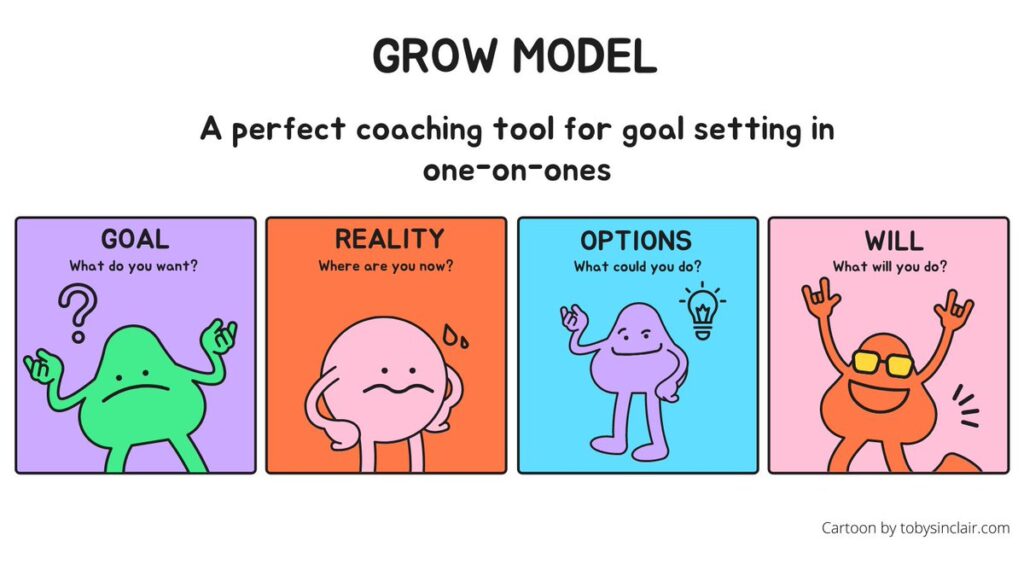Do you find yourself setting goals, only to lose motivation and fall short of achieving them? If so, you’re not alone. Many people struggle with goal setting and lack a clear plan of action. But fear not, because there is a proven framework that can help you overcome these challenges and achieve your goals with ease: the GROW Model. In this article, we will explore the GROW Model in-depth and provide practical tips for implementing it effectively in your life.
What is the GROW Coaching Model?
The GROW Model is a goal-oriented coaching framework that provides a structured approach to problem-solving and goal attainment. It was developed by Sir John Whitmore and his colleagues in the 1980s and has since become widely adopted by coaches, mentors, and individuals seeking personal and professional growth.
The GROW acronym stands for Goal, Reality, Options, and Will (or Way Forward). These four components serve as the foundation for the model and guide individuals through a systematic process of setting and achieving their goals.

Goal
The first step in the GROW Model is to establish a clear and specific goal. This entails defining what you want to accomplish and setting a target that is meaningful and achievable. By clearly articulating your goal, you create a sense of direction and purpose, which in turn increases your motivation and commitment to succeed.
Setting goals can be a daunting task, especially when faced with uncertainty or a lack of clarity. One strategy that can help overcome this hurdle is to break down your larger goal into smaller, more manageable milestones. By focusing on incremental progress, you can build momentum and gain a sense of accomplishment along the way. Additionally, seeking input from trusted mentors or coaches can provide valuable insights and guidance in setting clear and meaningful goals.
You might ask yourself:
What do I want to achieve in this session or in the long term?
How will I know when I have achieved this goal?
What does success look like for me in this context?
Why is this goal important to me?
What would achieving this goal mean for my personal or professional life?
Reality
Once you have identified your goal, the next step is to assess your current reality. This involves taking a realistic look at your current situation, strengths, weaknesses, and any obstacles or limiting beliefs that may impede your progress. By gaining a clear understanding of where you are starting from, you can better identify the steps needed to bridge the gap between your current reality and desired outcome.
What are some challenges or roadblocks that you anticipate encountering along the way to achieving your goals? How can you address them proactively?
When pursuing any goal, challenges and roadblocks are inevitable. It is important to anticipate and address them proactively to maintain momentum and stay on track. One effective strategy is to conduct a thorough SWOT (Strengths, Weaknesses, Opportunities, and Threats) analysis. This analysis helps identify potential obstacles and allows you to develop contingency plans to overcome them. Additionally, seeking support from a mentor or coach can provide valuable guidance and perspective when facing challenges.
You might ask yourself:
What is my current situation related to this goal?
What have I already tried, and what were the results?
What obstacles or challenges am I facing?
What resources or support do I currently have?
How do I feel about my current progress towards this goal?
Options (or Obstacles)
With a clear goal and a realistic assessment of your current reality, it’s time to explore the various options available to you. This stage of the GROW Model encourages creativity and open-mindedness, as you brainstorm and evaluate different strategies, resources, and approaches to achieving your goal. It’s important to consider a wide range of options before selecting the most feasible and effective ones.
Think outside the box for a moment: What alternative approaches or strategies could you consider to reach your goal?
When considering alternative approaches or strategies, it can be helpful to seek inspiration from various sources. This could include reading books or articles, attending workshops or seminars, or engaging in conversations with individuals who have successfully achieved similar goals. By expanding your knowledge and exploring different perspectives, you can discover innovative and unconventional approaches that may lead to breakthroughs in achieving your goal.
You might ask yourself:
What are all the possible ways I could achieve this goal?
What have others done in similar situations?
What are the pros and cons of each option?
Which option seems most feasible and effective?
Are there any additional resources or support I need to consider?
Will (or Way Forward)
The final component of the GROW Model is the action-oriented stage of will. After identifying the most promising options, it’s time to commit to a specific plan of action. This involves setting milestones, establishing deadlines, and holding yourself accountable to ensure progress towards your goal. The will stage also encompasses the perseverance and determination required to overcome challenges and stay motivated throughout the journey.
How will you hold yourself accountable to follow through with your action plan? Are there any support systems or mentors you can lean on for guidance and encouragement?
Accountability plays a crucial role in staying committed to your action plan. One effective way to hold yourself accountable is to share your goals and progress with a trusted friend, mentor, or coach. This external support system can provide guidance, encouragement, and a sense of responsibility to keep you on track. Additionally, establishing regular check-ins or progress reviews can help you stay focused and motivated, ensuring that you are consistently taking the necessary steps towards achieving your goal.
You might ask yourself:
What specific actions will I take to move towards my goal?
When will I start each action, and what is the timeline?
What milestones will I set to measure my progress?
How will I stay motivated and accountable?
What potential obstacles might arise, and how will I address them?
Diving Deeper into the GROW Model Components
Now that we have covered each component of the GROW Model, let’s delve deeper into how to effectively utilize them in practice.
Goal: The Power of Clarity
When setting your goal, aim to be specific and precise. Often, ambiguous or vague goals can lead to confusion and lack of focus. By clearly defining your goal, you create a roadmap that guides your actions and keeps you on track. Goals that align with your values and aspirations are likely to increase your motivation and commitment to seeing it through.
What are some strategies you can use to clarify your goal and ensure it is aligned with your values?
One strategy to clarify your goal is to break it down into smaller, more manageable sub-goals. By doing this, you can clearly see the steps you need to take to achieve your ultimate goal. Another strategy is to visualize your goal as if it has already been accomplished. This technique helps you connect with the emotions and feelings associated with achieving your goal, making it more tangible and real.
Be sure to seek feedback from trusted individuals who know you well, as they can provide valuable insights and perspectives, identify blind spots and ensure that your goal is aligned with your core values. Remember, the more clarity you have around your goal, the easier it will be to stay focused and motivated throughout the journey.
Reality: Facing the Truth
The reality stage is all about honesty and self-awareness. While it can be challenging, it’s important to objectively evaluate your current situation and acknowledge any gaps or limitations that may hinder your progress. By embracing the truth, you lay the foundation for growth and improvement. It’s not all bad though – this stage also involves identifying your strengths and resources that can be leveraged to your advantage.
Are there any limiting beliefs or negative self-talk that you need to address in order to move forward?
Addressing limiting beliefs and negative self-talk is essential for personal growth. Your self-imposed barriers are likely holding you back from reaching your full potential. An effective strategy to overcome limiting beliefs is to challenge them with evidence and counterexamples. When you find yourself in a moment of negative self-talk, ask yourself if there is actually any concrete evidence that supports these beliefs or if they are merely assumptions based on past experiences.
Having the ability to reframe negative self-talk into positive affirmations is another strategy. Replace statements like “I can’t do it” with “I am capable of overcoming challenges.” By consciously changing your internal dialogue, you can cultivate a more empowering mindset and create a positive foundation for progress. You’ll be well on your way from moving from a fixed mindset to a growth mindset.
Options: Embracing Possibilities
During the options (or obstacles) stage, it is important to consider a wide range of possibilities and explore different perspectives and approaches. The sky is the limit! Avoid limiting yourself to conventional or familiar solutions. Embrace creativity and think outside the box. If you need ideas, seek input from mentors, friends, or colleagues who can provide fresh insights and novel ideas.
What are some unconventional options or strategies that you could consider to overcome obstacles and achieve your goal?
Cultivating a growth mindset emphasizes the belief that abilities and intelligence can be developed through dedication and hard work. By embracing a growth mindset, you open yourself up to new possibilities and are more willing to take risks and learn from failures.
Another strategy is to practice divergent thinking. This involves generating multiple ideas and solutions without judgment or evaluation of them – and it takes practice. Allow your mind to wander and explore different avenues, even if they seem far-fetched at first. Sometimes, the most innovative and effective solutions come from thinking outside the box.
Will: Taking Action and Staying Accountable
The will (or way forward) stage is where the rubber meets the road. It’s not enough to have a well-defined goal and a plethora of options; you actually need to take decisive action to bring your goal to fruition. Break down your action plan into manageable steps, set deadlines, and establish a system of accountability to keep yourself motivated and on track. Surround yourself with like-minded individuals or mentors who can support you and provide guidance when needed.
Who can you enlist as an accountability partner to help you stay motivated and committed to your action plan?
Enlisting an accountability partner can greatly enhance your chances of success. This person can be a friend, colleague, or mentor who shares your aspirations and is willing to hold you accountable for your actions. They can provide encouragement, check in on your progress, and offer guidance when you face challenges.
Additionally, joining a mastermind group or finding a mentor who has already achieved similar goals can provide valuable support and accountability. These individuals can offer insights, share their experiences, and help you stay motivated and committed to your action plan.
Implementing the GROW Model in Practice
Now that you have a solid understanding of the GROW Model components, it’s time to put them into practice. Here are some practical tips to help you implement the GROW Model effectively:
- Set aside dedicated time for goal setting and planning. Create a quiet and conducive environment that allows you to reflect and focus on defining your goals.
- Be open to feedback and different perspectives. Seek the input of mentors or trusted individuals who can provide valuable insights and guidance.
- Regularly review and revise your action plan as needed. Adapt to changing circumstances and be flexible in your approach.
- Enjoy the journey. Remember that goal setting and achievement is a process, not a destination. Celebrate small wins along the way and embrace the lessons learned from setbacks.
Overcoming Common Challenges in Goal Setting
Goal setting is not without its challenges. In order to overcome these hurdles, it is important to be aware of them and develop strategies to navigate through them effectively. Here are some common challenges and tips for overcoming them:
- Procrastination: Break your goal into smaller, actionable tasks to avoid feeling overwhelmed. Set deadlines and hold yourself accountable.
- Lack of motivation: Continually remind yourself of the reasons why you set your goal in the first place. Visualize the end result and the positive impact it will have on your life.
- Fear of failure: Embrace failure as a learning opportunity and a stepping stone towards success. Develop a growth mindset and view setbacks as temporary obstacles.
Have you encountered any of these challenges in the past? How did you overcome them? Share your tips and strategies in the comments below!
Leveraging Accountability Partners for Success
Human beings are social creatures, and having a support system can greatly enhance your chances of success. One powerful way to stay accountable and motivated is to enlist the help of an accountability partner. An accountability partner is someone who shares your goals and values and is committed to supporting your journey. This could be a friend, family member, colleague, or mentor.
An accountability partner can provide encouragement, guidance, and perspective. They can hold you accountable for your actions and help you stay on track when you feel tempted to veer off course. Weekly check-ins or regular progress updates can help keep you focused and motivated in pursuit of your goals.
Do you have an accountability partner in your life? If not, who is someone you could approach to be your accountability partner?
Reflecting on Lessons Learned and Setting New Goals
As you work through the GROW Model and make progress towards achieving your goals, it is important to take time to reflect on the lessons learned along the way. What worked well? What could have been done differently? Celebrate your successes and acknowledge the areas for improvement.
This reflection phase is also an opportune time to set new goals. Goal setting is a continuous process, and as you achieve one goal, it’s important to set new ones to continue growing and challenging yourself.
What are some new goals that you would like to set for yourself? How will they contribute to your personal and professional growth?
Conclusion
By mastering the GROW Model, you can overcome the challenges of goal setting and achieve your goals with ease. The GROW Model provides a clear and structured framework for goal attainment, guiding you through the essential steps of defining your goal, assessing your current reality, exploring options, and taking decisive action. By leveraging accountability partners, embracing mentorship, and adopting a growth mindset, you can accelerate your progress and set yourself up for success.
Remember, success doesn’t happen overnight. It takes dedication, perseverance, and a willingness to step outside your comfort zone. So, embrace the GROW Model, stay committed to your goals, and watch as you transform your aspirations into reality.
Ready to elevate your mentoring program and achieve your organizational goals with precision?
Discover how Mentorloop can streamline your mentoring journey, from initiation to success measurement. Whether you’re an HR and L&D Leader, a Functional Leader of a large team, a Community Manager, or a Leader in Professional Development, Mentorloop is designed to support your unique needs. We also have a special Community Support Program for Charities and Nonprofits. Don’t miss the opportunity to run your best mentoring program yet. Book a Demo today and take the first step towards unlocking your team’s full potential.




